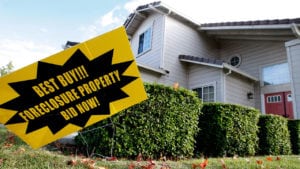REOs are a significant part of the housing market and can be great deals for buyers, but there are some things you need to know before investing in one.
Buying a foreclosed home is not like the typical home purchase. In many cases:
- Only one real estate agent is involved.
- The seller wants a preapproval letter from a lender or proof of funds letter before accepting an offer.
- There is little, if any, room for negotiation.
- The home is sold as-is, and it’s up to the buyer to pay for repairs.
On the upside, most bank-owned homes are vacant, which can speed up the process of moving in.
Buying a foreclosure is definitely a bit of a grind. It’s not easy. You’re getting fantastic pricing, but sometimes it takes going through a lot of houses and writing a lot of offers to get the home you want.
5 steps to buying a foreclosure home
- Find an agent specializing in foreclosures. (Lucky for you, Michael Vargas knows all about foreclosures)
- Get pre-approved for a mortgage. (Not needed if you’re paying cash)
- Know how long it takes to sell a home in your price bracket.
- Study the sale prices of comparable homes in your area.
- Remember, the home is sold as-is.
Find a real estate broker and a lender
The first two steps for buying a foreclosure should be taken at the same time. While you’re looking for a real estate broker (Michael Vargas) who works directly with banks that own foreclosed homes, get a preapproval letter from a lender.
You might find the acronym REO, which means “real estate owned.” This signifies that the property has been foreclosed on and the lender now owns it and is selling it.
Get a broker on your side
The goal of combing through foreclosure listings is not to find a house; it’s to find an agent. Banks usually hire real estate brokers to handle their REO properties. In many cases, the buyer works directly with the bank’s broker instead of using a buyer’s agent. That way, the commission doesn’t have to be split between two brokers.
We have a long-term relationship with these banks, and know of listings that haven’t even hit the MLS yet. Give Michael a call about the listings that you’re interested in, but also ask him about listings that may be coming up because sometimes it may take a day or two or even a week before a listing actually comes onto the database.
To prove that you’re serious about buying, right before or after you meet with Michael, meet with a lender.
Get a preapproval letter
Unless you plan to pay cash, you’ll need a recent preapproval letter from a lender. The letter will detail how much money you can borrow, based on the lender’s assessment of your credit score and income.
The problem is, buyers want to find the house first, and then they think they’ll work out the financing. But the problem is, the really good deals on these bank-owned, they go quick — and the buyer doesn’t necessarily have time to try to work out the financing afterward. You would need to work that out first.
Some first-time buyers make the mistake of assuming that the bank selling the home will also finance the mortgage as part of the deal. “Don’t expect to get financing from the bank that foreclosed on it. That’s a totally separate transaction, and they view it that way. The people in the (bank’s) REO department are not loan officers. They are getting rid of bad assets.
Look at ‘comps’ before making an offer
There’s no rule of thumb on what the bank’s bottom line is on price. Just as with any other real estate purchase, you have to look at the recent sales prices of comparable properties, or “comps.”
“You really have to look at the comps in today’s current market conditions and write a competitive offer based on that. Sometimes the bank prices the homes really low, and the home will have multiple offers over list price within hours.
Sometimes it’s priced too high, and you can come in lower. A lot of times, buyers will come to me and say, ‘We want to write offers for half price.’ It just doesn’t work that way.
‘Bid the higher price’ if homes are selling quickly
Keep in mind that foreclosed houses generally are sold as-is. That means that you shouldn’t expect to get a discount to compensate for repairs.
Let’s say the house is listed for $200,000, all the comps are $200,000, and so the client comes in and says, ‘Hey, look, I want to buy this house but I’ve got to do paint, carpet and fix some mold damage, so I want to take $15,000 off the price.’ You know what? All the other ones were in the same condition, and they sold for $200,000.
With foreclosures, a 3,500-square-foot house with a pool in a gated community might sell within days or hours, but more modest homes might sit on the market for weeks. Or vice versa, depending on market conditions.
If the foreclosed homes you’re looking at are selling swiftly, “the best advice on a bank-owned property is to come in at your highest and best, unless the property has been sitting on the market forever with no activity.
If you’re going to be upset because you would have gone $5,000 more but you lost the property, just bid the higher price in the first place.
Find tradespeople who can assess, repair damage
Because repairs are almost inevitable with foreclosed houses, I recommend getting to know tradespeople who can assess and repair damage from pests, mold and leaks. You should assume that the air conditioning needs to be fixed, and possibly the heating system, too.
It all sounds daunting. But at least you don’t have to wait for the owner to move out of the house.
Active foreclosure homes on the market:





